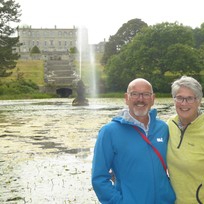( Overview
/ Two Bullocks on a Boat Go West
Another sunny day, but the high winds mean we’re being blown onto the pontoon; this boat used a rib as a tug to move off. Over night we were again visited by a ‘wild animal’, this time a cat. We haven’t seen it, but there’s a poster warning it will steal food if left out.
When the Martello Towers were built, a signal tower, a barracks for 2 officers and 150 men, a quay and storehouses were also constructed.
In 1898 raised a compulsory purchase order to construct additional fortifications to protect the British Fleet at anchor in Berehaven Harbour.
During the Irish War of Independence some Irish republicans were interned on Bere Island, including Canon William Kennedy.
Under the terms of the Anglo-Irish Treaty, the British withdrew form most of Ireland, but three deep water bases, including Berehaven were retained as sovereign bases until 1938. As these were handed back at this time, this meant Ireland could remain neutral during World War II.
A permanent Irish Army Garrison remained on the island from 1938 to 1947. Sadly we just missed the tour of the Lonehort Battery which take place Saturday, Sundays and Wednesdays.
There are lots of derelict buildings scattered throughout the island, some with applications for development.
There are also many dumped cars and vans. We couldn’t work it out initially, but realised this van has been repurposed…
Lonehort or Longphort is of Norse origin, meaning a fortified ship harbour; an artificial breakwater formed by dumping a large amount of stones is at the entrance to the harbour, and there is evidence of a Naust on the shoreline. Nausts are Scandinavian shelters used for repair of boats.
Looking for Scairt Beach in Lonehort Harbour, we took a wrong turn, ending up at the wrong end of the bay.
Stopping at a viewpoint, I cut Kevin’s hair. I also trimmed his beard, which he wasn’t so happy about!
Rachael had given us very precise instructions to find Scairt Beach (not visible until you’re there), and we finally followed them rather than what we thought. Firstly you find a new build house with a derelict one opposite, and go down the lane next to it.
There’s no sign this is the way, and we might not have gone through a tied up gate, if we hadn’t seen a car with a kayak on the roof coming in the opposite direction.
This gate marks the entrance to an Army Firing Range, but a kissing gate to one side (and Rachael’s assurance to ignore the signs unless there’s a red flag), meant we kept walking.































 Sign in with Apple
Sign in with Apple  Log in with Facebook
Log in with Facebook